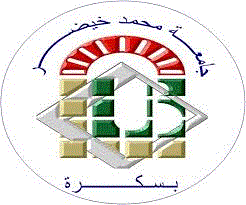| Titre : | Fog computing task scheduling based on simulated annealing algorithm |
| Auteurs : | Ayoub Labed, Auteur ; Salim Bitam, Directeur de thèse |
| Type de document : | Monographie imprimée |
| Editeur : | Biskra [Algérie] : Faculté des Sciences Exactes et des Sciences de la Nature et de la Vie, Université Mohamed Khider, 2018 |
| Format : | 1 vol. (80 p.) / 30 cm |
| Langues: | Anglais |
| Mots-clés: | Fog Computing,Task Scheduling,Simulated Annealing Algorithm |
| Résumé : |
Internet of Things (IoT) aims to bring online every object (e.g. sensors, cameras, and vehicles), therefore generating large amounts of data that can overpower storage systems and data analytics applications. Cloud computing offers services at the infrastructure level that can scale to IoT storage and processing requirements. However, there are applications such as health monitoring and emergency response that require low latency, and delay caused by transferring data to the cloud and then back to the application can seriously affect their performances. To overcome this limitation, Fog computing paradigm proposed as a powerful complement to the cloud, where cloud services are extended to the edge of the network to reduce transmission latency. To realize the full potential of Fog and IoT paradigms for real-time analytics, several challenges need to be addressed. The first and most critical problem is designing resource management techniques that improves the quality of service (QoS). This work proposes a task scheduling algorithm in the fog layer called Fog Simulated Annealing algorithm (FSA). FSA is based on the annealing in metallurgy, a technique involving heating and controlled cooling of a material to increase the size of its crystals and reduce their defects. We tackle the objective of achieving the balance between the makespan and the monetary cost of fog resources. It is considered as NP-Complete problem and it aims at spreading the workloads among the processing resources in an optimal way to achieve tradeoff between the total cost and execution time of tasks. In order to evaluate the effectiveness and the performance of this proposal, a set of experimental tests has been conducted. After comparison with genetic algorithm (GA) and FIFO on iFogSim Simulator, the reached results showed that our proposed algorithm achieves better tradeoff value than other algorithms with less complexity. |
| Sommaire : |
Deduction I Acknowledgements II الملخص III Résumé IV Abstract V List of tables VI List of graphs VI Table of Contents VII General introduction ................................................................................................................... 1 Chapter 1. Fog Computing ..................................................................................................... 3 1.1. Introduction ................................................................................................................ 3 1.1. Definition of fog computing ......................................................................................... 3 1.2. Fog computing architecture ......................................................................................... 4 1.3. Essential characteristics ............................................................................................... 5 1.4. Application areas ......................................................................................................... 6 1.5. Challenges of Fog computing and research directions .................................................. 8 1.5.1. Architectural Challenges and Research Directions ................................................ 8 1.5.2. Algorithmic Challenges and Research Directions .................................................. 8 1.6. Task scheduling problem in the fog computing ............................................................ 9 1.6.1. Definition ............................................................................................................. 9 1.6.2. Motivation ........................................................................................................... 9 1.7. Conclusion ................................................................................................................. 10 Chapter 2. Task scheduling in Fog computing: A state of the art .......................................... 11 2.1. Introduction .............................................................................................................. 11 2.2. Optimization .............................................................................................................. 11 2.2.1. Definitions ......................................................................................................... 11 2.2.2. Optimization problem types ............................................................................... 12 2.2.3. Optimization approaches ................................................................................... 13 2.3. Fog computing task scheduling problem .................................................................... 15 2.3.1. Definitions ......................................................................................................... 15 Fog Computing task scheduling based on simulated annealing algorithm 2.3.2. Related works on fog comuting task scheduling ................................................. 17 2.4. Conclusion ................................................................................................................. 19 Chapter 3. The general design ............................................................................................. 20 3.1. Introduction .............................................................................................................. 20 3.2. Contributions............................................................................................................. 20 3.3. System model ............................................................................................................ 20 3.4. Problem formulation ................................................................................................. 23 3.5. Fog Simulated Annealing Algorithm ........................................................................... 24 3.5.1. Origin of the algorithm ....................................................................................... 24 3.5.2. The basic properties of the simulated annealing algorithm ................................ 24 3.5.3. Advantages of simulated annealing algorithm .................................................... 25 3.6. Fog Simulated annealing for task scheduling .............................................................. 26 3.6.1. FSA Algorithm Illustration .................................................................................. 26 3.6.2. FSA Algorithm representation, evaluation and stopping criterion ....................... 29 3.6.3. FSA Algorithm operators .................................................................................... 29 3.7. Conclusion ................................................................................................................. 30 Chapter 4. Experimental study ............................................................................................ 31 4.1. Introduction .............................................................................................................. 31 4.2. The iFogSim simulator ............................................................................................... 31 4.3. Experimental settings ................................................................................................ 32 4.1. Application preview ................................................................................................... 34 4.2. Experimental results .................................................................................................. 45 4.3. Conclusion ................................................................................................................. 47 General conclusion ................................................................................................................... 48 References 49 |
Disponibilité (1)
| Cote | Support | Localisation | Statut |
|---|---|---|---|
| MINF/384 | Mémoire master | bibliothèque sciences exactes | Consultable |




